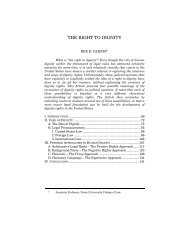A Right to Media? Lorie M. Graham - Columbia Law School
A Right to Media? Lorie M. Graham - Columbia Law School
A Right to Media? Lorie M. Graham - Columbia Law School
Create successful ePaper yourself
Turn your PDF publications into a flip-book with our unique Google optimized e-Paper software.
2010] A RIGHT TO MEDIA? 455<br />
racism and discrimination. 93 Second, take steps <strong>to</strong> ensure that the<br />
workforce is diverse and reasonably representative of society. 94<br />
Finally, “ensure that reporting in relation <strong>to</strong> specific communities<br />
promotes a better understanding of difference and at the same time<br />
reflects the perspectives of those communities and gives members of<br />
those communities a chance <strong>to</strong> be heard.” 95<br />
These suggestions fall in line with Article 16’s call for access<br />
<strong>to</strong> media for indigenous peoples and for the representation of<br />
indigenous peoples’ cultural diversity in state- and privately-owned<br />
media. The issue of ensuring that indigenous cultural diversity is<br />
represented in media takes on even more importance in light of the<br />
facts that informed the 1995 Resolution on the Prevention of<br />
Incitement <strong>to</strong> Hatred, Particularly by the <strong>Media</strong> by the Sub-<br />
Commission on Prevention of Discrimination and Protection of<br />
Minorities. The resolution categorically condemned the “role played<br />
with increasing frequency by some printed or audiovisual media in<br />
inciting genocidal hatred.” 96<br />
Some states may express concern with the duty under Article<br />
16 of the UNDRIP <strong>to</strong> take “effective measures . . . without prejudice<br />
<strong>to</strong> ensuring full freedom of expression [<strong>to</strong>] encourage privately owned<br />
media <strong>to</strong> adequately reflect indigenous cultural diversity,”<br />
particularly when one considers the longstanding tradition in<br />
international law of limiting the role of the state in controlling<br />
privately owned media. 97 However, these two obligations <strong>to</strong> promote<br />
freedom of expression as well as cultural diversity in media are not<br />
mutually exclusive as various provisions of the ICCPR and CERD<br />
demonstrate.<br />
As earlier discussed, Article 20(2) of the ICCPR (similar <strong>to</strong><br />
Article 4 of CERD) has long precluded any advocacy of national,<br />
racial, or religious hatred that “constitutes incitement <strong>to</strong><br />
discrimination, hostility or violence,” regardless of whether the aims<br />
of such incitement are internal or external. 98 Such prohibitions have<br />
93. Id.<br />
94. Id.<br />
95. Id.<br />
96. ECOSOC, Sub-Comm’n on Prevention of Discrimination & Prot. of<br />
Minorities, Prevention of Incitement <strong>to</strong> Hatred, Particularly by the <strong>Media</strong>, para. 5,<br />
U.N. Doc. E/CN.4/Sub.2/1995/L11/Add.2 (Aug. 18, 1995).<br />
97. UNDRIP, supra note 20, art. 16.<br />
98. Human <strong>Right</strong>s Comm., General Comment 11: Article 20 Prohibition of<br />
Propaganda for War and Inciting National, Racial or Religious Hatred, paras.<br />
1–2 (July 29, 1983). Article 13(5) of the American Convention on Human <strong>Right</strong>s















